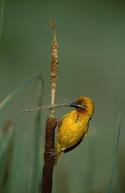Name
Cape weaver (Ploceus Capensis)Appearance

The male Cape weaver is a large weaver, at 17 cm in length, with a long pointed black bill and a pale eye.
The breeding male has yellow underparts and head, with an orange face mask and the bill is brown.
The male will lose the orange face mask outside of the breeding season.
The female has an olive-yellow coloured breast and head, shading to a pale yellow on the belly.
The female’s eyes and bill are brown.
Diet
The Cape weaver is omnivorous and feeds on insects, seeds, fruit and nectar. This bird is one of the major pollinators of aloe flowers in South Africa.Cape Weaver Breeding
The Cape weaver is polygynous (the breeding practise of a male breeding with more than one female at the same time) and colonial. The male will have up to seven breeding females in his territory.
The Cape weaver male is very territorial and will defend his territory with vigour. The male Cape weaver will build a nest and try and attract a female to it, by hanging upside down from the nest and flapping his wings, while making a buzzing call. Before a female will accept the nest, she will test the quality, by trying to pull it apart for the inside.
Once she has accepted the nest, the male will build an entry tunnel, whilst the female Cape weaver lines the inside with feathers, grass and leaves. The female will lay between 2 and 5 eggs and incubation is carried out by the female, the chicks hatch after around 14 days.
The female feeds the chicks and they fledge after 16 to 20 days. The Cape weaver is parasitised by the Diederik cuckoo.
Behaviour
All the nests are built by the male Cape weaver, each nest takes around 7 days to build. The nests are kidney-shaped and waterproof, woven from strips of reeds or grass. The nests are built at the tip of branches or reeds, over water. Outside of the breeding season, Cape weavers form large flocks and roosts.Threats
The Cape weaver is of least concern. They are known as a pest in orchards and agricultural lands in the Western Cape. Snakes, rats and harrier hawks rob the nests of the Cape weaver, for the eggs and chicks.Distribution and Habitat
The Cape weaver is endemic to South Africa and is found across the country, excluding very arid areas.The Cape weaver occurs in open grassland, lowland fynbos, around farms and along the coast in coastal thickets, close to permanent water.